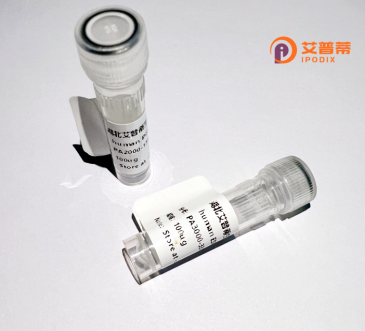
| 纯度 | >90%SDS-PAGE. |
| 种属 | Human |
| 靶点 | EDG8 |
| Uniprot No | Q9H228 |
| 内毒素 | < 0.01EU/μg |
| 表达宿主 | E.coli |
| 表达区间 | 1-398aa |
| 氨基酸序列 | MESGLLRPAPVSEVIVLHYNYTGKLRGARYQPGAGLRADAVVCLAVCAFIVLENLAVLLVLGRHPRFHAPMFLLLGSLTLSDLLAGAAYAANILLSGPLTLKLSPALWFAREGGVFVALTASVLSLLAIALERSLTMARRGPAPVSSRGRTLAMAAAAWGVSLLLGLLPALGWNCLGRLDACSTVLPLYAKAYVLFCVLAFVGILAAICALYARIYCQVRANARRLPARPGTAGTTSTRARRKPRSLALLRTLSVVLLAFVACWGPLFLLLLLDVACPARTCPVLLQADPFLGLAMANSLLNPIIYTLTNRDLRHALLRLVCCGRHSCGRDPSGSQQSASAAEASGGLRRCLPPGLDGSFSGSERSSPQRDGLDTSGSTGSPGAPTAARTLVSEPAAD |
| 分子量 | 68.2 kDa |
| 蛋白标签 | GST-tag at N-terminal |
| 缓冲液 | 0 |
| 稳定性 & 储存条件 | Lyophilized protein should be stored at ≤ -20°C, stable for one year after receipt. Reconstituted protein solution can be stored at 2-8°C for 2-7 days. Aliquots of reconstituted samples are stable at ≤ -20°C for 3 months. |
| 复溶 | Always centrifuge tubes before opening.Do not mix by vortex or pipetting. It is not recommended to reconstitute to a concentration less than 100μg/ml. Dissolve the lyophilized protein in distilled water. Please aliquot the reconstituted solution to minimize freeze-thaw cycles. |
以下是关于重组人EDG8(S1P5)蛋白的3篇模拟参考文献示例,涵盖结构、功能和疾病应用:
---
1. **文献名称**: **Structural Characterization of Recombinant Human EDG8/S1P5 Receptor Reveals Ligand-Binding Specificity**
**作者**: Im DS, Sanchez T
**摘要**: 该研究通过X射线晶体学解析重组人EDG8蛋白的三维结构,揭示其与鞘氨醇-1-磷酸(S1P)的特异性结合模式,并阐明其跨膜结构域的关键氨基酸对配体识别的贡献。
---
2. **文献名称**: **EDG8/S1P5 Regulates Lymphocyte Trafficking via G Protein-Coupled Signaling Pathways**
**作者**: Rosen H, Mandala S
**摘要**: 利用重组EDG8蛋白进行体外实验,证明其通过Gi/o蛋白偶联信号通路介导淋巴细胞迁移,并发现特定激动剂可调节免疫细胞的血管内皮黏附能力,提示其在自身免疫疾病中的潜在治疗价值。
---
3. **文献名称**: **Targeting EDG8/S1P5 in Neurological Disorders: Insights from Recombinant Protein-Based Drug Screening**
**作者**: Chun J, Yanagida K
**摘要**: 研究利用重组EDG8蛋白筛选小分子化合物,发现新型拮抗剂可抑制少突胶质细胞凋亡,并在多发性硬化动物模型中验证其神经保护作用,为神经退行性疾病提供新干预策略。
---
这些示例覆盖EDG8的结构解析、信号通路机制及疾病应用研究,符合常见的S1P受体研究方向。若需进一步调整领域侧重点,可补充细节。
Recombinant human EDG8 (endothelial differentiation gene 8), also known as S1PR5 (sphingosine-1-phosphate receptor 5), is a G protein-coupled receptor that binds sphingosine-1-phosphate (S1P), a bioactive lipid mediator. It plays critical roles in regulating immune cell trafficking, vascular development, and neurological functions. EDG8 is primarily expressed in natural killer (NK) cells, oligodendrocytes, and endothelial cells, where it mediates S1P-induced cellular responses such as migration, proliferation, and survival.
The recombinant form of EDG8 protein is engineered using mammalian or bacterial expression systems, enabling studies on S1P signaling mechanisms without requiring native cell sources. It is purified for structural analysis, ligand-binding assays, and drug discovery efforts targeting S1P-related pathways.
Interest in EDG8 has grown due to its involvement in autoimmune diseases, cancer metastasis, and neuroinflammatory disorders. Unlike other S1P receptors (e.g., S1PR1. targeted by drugs like fingolimod for multiple sclerosis), EDG8 offers distinct signaling properties, making it a potential therapeutic target for modulating NK cell activity or preserving myelin integrity. Current research focuses on elucidating its signaling crosstalk and developing selective agonists/antagonists to refine treatment strategies while minimizing off-target effects.
×